
Byakkotai
Byakkotai, the White Tiger Unit
Aizu-Wakamatsu is in a flat basin surrounded by mountains.
The city sits against the hills and mountains along
the southeast edge of that basin.
The graves of the Byakkotai
or the White Tiger Unit
are up the mountain slope overlooking the city.
That was a group of teen-aged samurai warriors
who were involved in the
Boshin War
of 1868–1869,
part of the cluster of civil wars that broke out
during the transition from the Shōgunate
to the Meiji Restoration,
the Emperor's return to power.
They're famous for having erroneously committed ritual suicide
when they thought that Aizu-Wakamatsu's castle had fallen.
There are no do-overs in seppuku.
There's a sort of ring road around Aizu-Wakamatsu, the memorial is east-northeast of the center. You start up from the road between shops selling souvenirs and snacks.
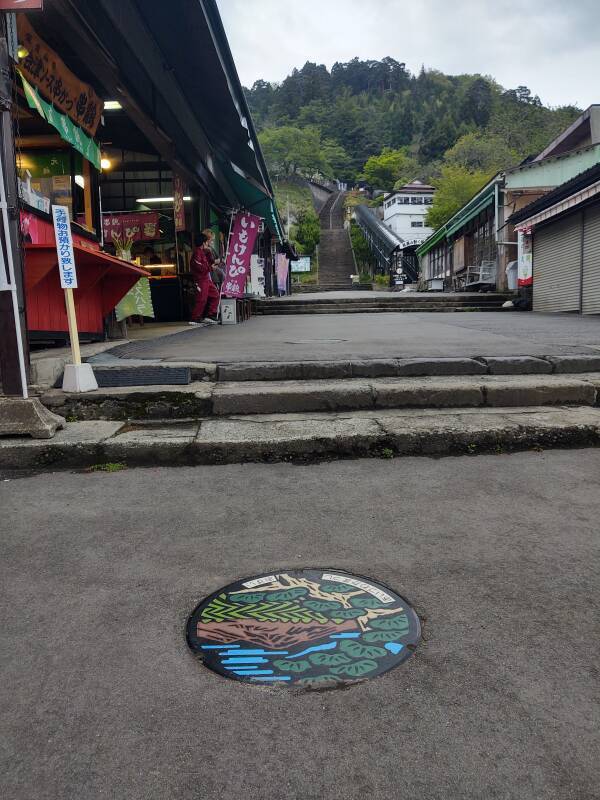
Climbing the Hill
There's a covered escalator you can pay to ride it up the hill. It's in what looks like a tube to the right of the stairs seen in the above picture.
I simply walked up the stairs. It's a climb of about forty meters elevation to reach the memorial. Pausing to look back, the tree-covered hill with the Ōtsukayama Kofun is just to the of the center of this view.
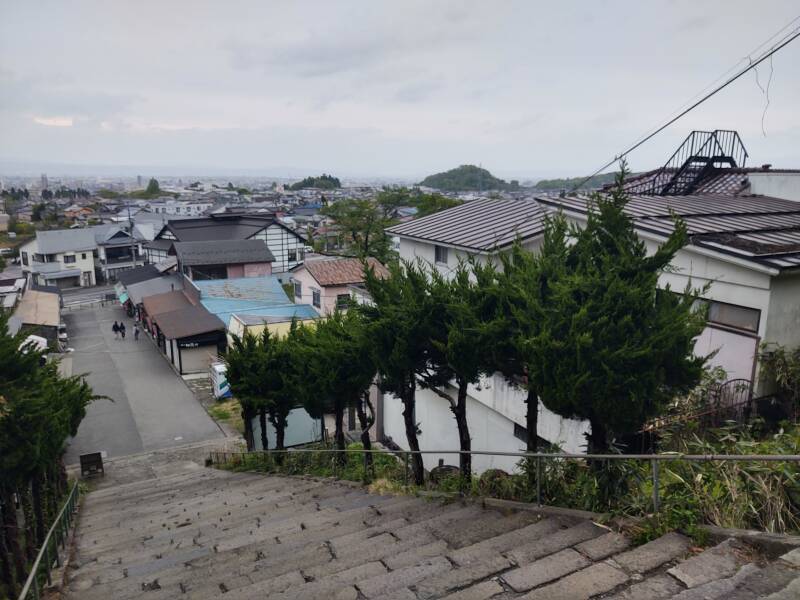
Close to the level of the graves, there's a nice view over the center of Aizu-Wakamatsu. You look out over the covered escalator beside the stairs.
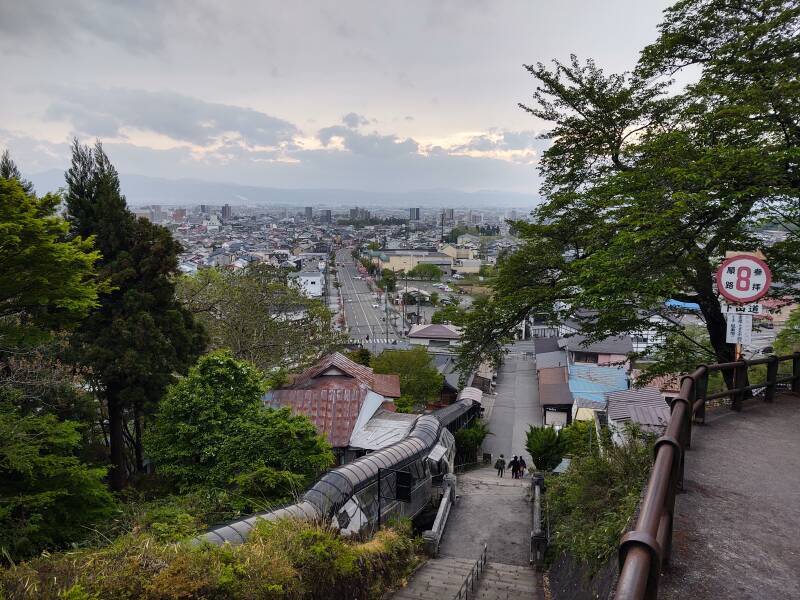
The Boshin War
Warlords always had local to regional control in Japan. From 1185 to 1868 a series of Shōguns nominally appointed by the Emperor (or controlling regents of the Imperial Court) were the military rulers of the entire country.
Local daimyō or warlords based in castles like the one in Aizu-Wakamatsu commanded samurai warriors to control their realms.
Then Matthew Perry led his fleet of U.S. Navy ships into Edo harbor in 1853. Edo was the Shōgun's capital, known for its "Floating World" of pleasure districts. And, unfortunately, outdated artillery. Perry demonstrated that his ships could shell Edo while staying out of range of the Shōgun's defensive cannons. The Shōgun was forced to capitulate to Perry's demand to open Japan's ports to U.S. trading ships.
The people and the Emperor lost confidence in the Shōgun. It took a few years, but the Shōgunate eventually collapsed. The Emperor took control of ruling Japan, moving from Kyōto where the Imperial Court had focused on Shintō ritual to Edo, which was renamed Tōkyō and began growing. That came to be called the Meiji Restoration.
That Emperor had been named Mutsuhito at birth in 1852. During his reign from 1867 to his death in 1912, he was simply known as "The Emperor". He was known as Meiji after his death, with his reign known as the Meiji Era. This was the start of the modern use of posthumous names in Japan. Hirohito, who ruled as Prince Regent on behalf of his neurologically impaired father 1921–1926 and as Emperor 1926–1989, is now known as the Shōwa Emperor. Then there was the Heisei Emperor (born Akihito) until he abdicated in 2019, and now we're in the Reiwa Era of his son Naruhito.
There was a general state of unrest from 1853 to 1869, with various civil wars. The Boshin War lasted from January 1868 through June 1869. It was disgruntled nobles and samurai fighting against Imperial government forces. Tokugawa Yoshinobu, the last Shōgun, had abdicated and turned over power to the young Emperor.
As part of the Boshin War, the Battle of Aizu ran from October into November in 1868.
By 1868 the Imperial government had upgraded their artillery by buying western weapons, and its forces were shelling Aizu-Wakamatsu's Tsuruga Castle from the surrounding hills. The castle, last rebuilt in 1611, couldn't hold out.
Byakkotai in the Battle of Aizu
The Byakkotai or the White Tiger Unit was named for the White Tiger of the West, one of the Four Symbols or Four Guardians of the Chinese constellations. It included stars that today are grouped into Andromeda, Aries, Taurus, and Orion.
The Byakkotai formed one of Aizu's four military units. It was a reserve unit, as it was made up of over 300 sons of Aizu samurai, meant to be limited to those 16 and 17 years old but a few younger ones had sneaked in.
A group of twenty of the Byakkotai got separated from the Aizu forces after a battle. They climbed part-way up Iimori Mountain. They wanted to see what was happening at Tsuruga Castle, 2.7 kilometers away.
They were looking over the town, and mistook smoke rising from the town as a sign of fire at the castle. There was an argument about what they should do, but eventually they decided upon seppuku, ritual suicide by disemboweling.
However, the castle had not yet fallen, it was premature seppuku.
One of the twenty, Iinuma Sadakichi, survived his attempt. Well, it's not as if you can practice ritual suicide and get really good at it. He was just 14 years old, having lied about his age to enlist in the unit. A samurai's wife found him still alive and rescued him. If he hadn't survived, the details wouldn't have been known and the unit wouldn't have become so famous.
The Graves
The Byakkotai graves and associated monuments are around a level clearing part-way up Iimori Mountain.
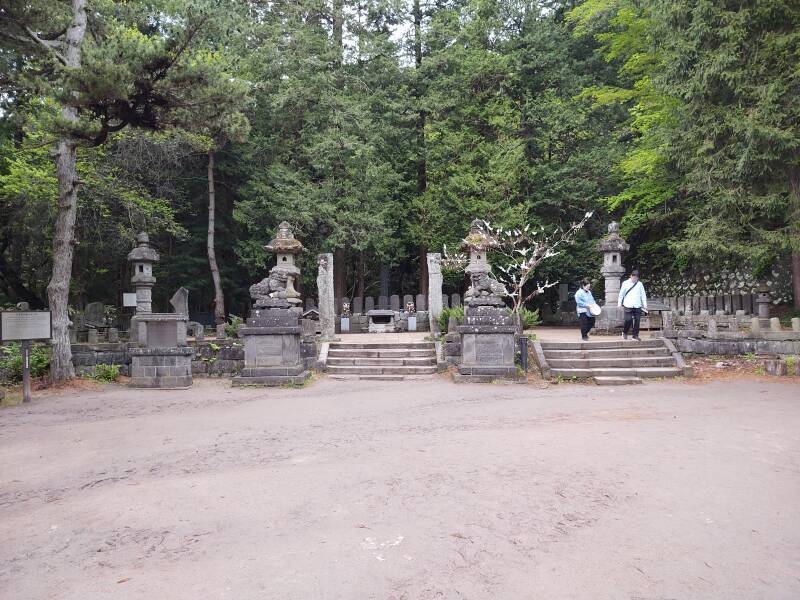
A sign in the grave complex says:
Grave of the Byakkotai
The Byakkotai Soldiers were several ranked troops consisting of young 16 and 17 year old men.
The tomb in front was and is the final resting spot of the 19 members of the 2nd Byakkotai Brigade who took their own lives here at Iimoriyama, on October 8th, 1868. Though the forces of the Meiji government forbade people from burying the bodies of these fallen soldiers, local villagers secretly transported their remains to Myokokuji Temple, where they were temporarily buried. They were later reburied at this spot.
The tomb on the right was built in 1900, and contains the remains of those who died nearby (31 soldiers: 3 from the upper rank, 22 from the middle rank, and 6 from the lowest rank).
The tomb on the left was built in memory of the 62 young 14 to 17 year old samurai who fought and died alongside grown men in Kyoto, Niigata, and Tochigi, in territories where there were no Byakkotai units in place. The monument was built in 2001, for the "Comrades of the Byakkotai".
The Byakkotai are just a few of the hundreds of people from Aizu who performed seppuku. Many wives and children of samurai, and many elderly residents, killed themselves around the time of Aizu's fall. A monument here honors 230 women and children.
A sign by this monument says:
Monument to the Fallen Aizu Clan Members
Representatives including Kenjiro Yamakawa
(former member of a different Byakkotai brigade,
and former president of Tokyo University)
built this monument at the former location of the
Byakkotai graves in 1928,
in remembrance of the 230 women and children of the Aizu clan
who died in the Boshin War (1868).
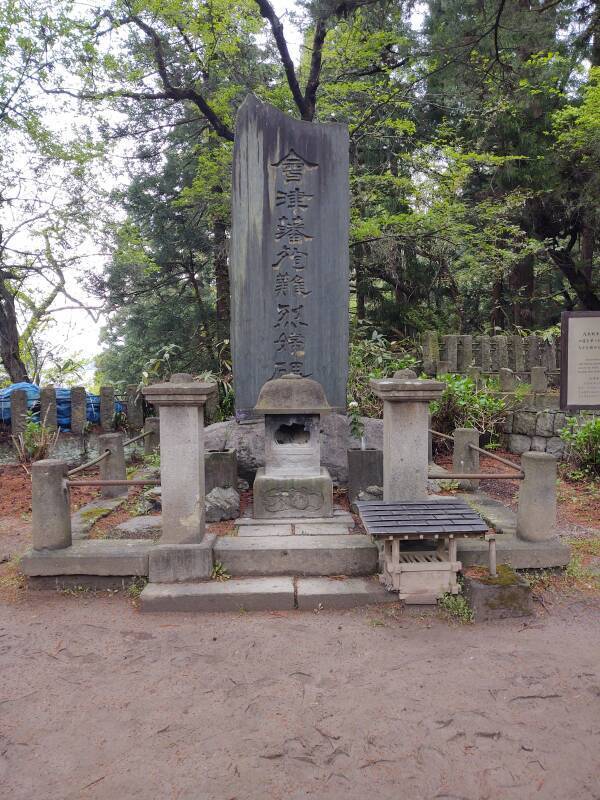
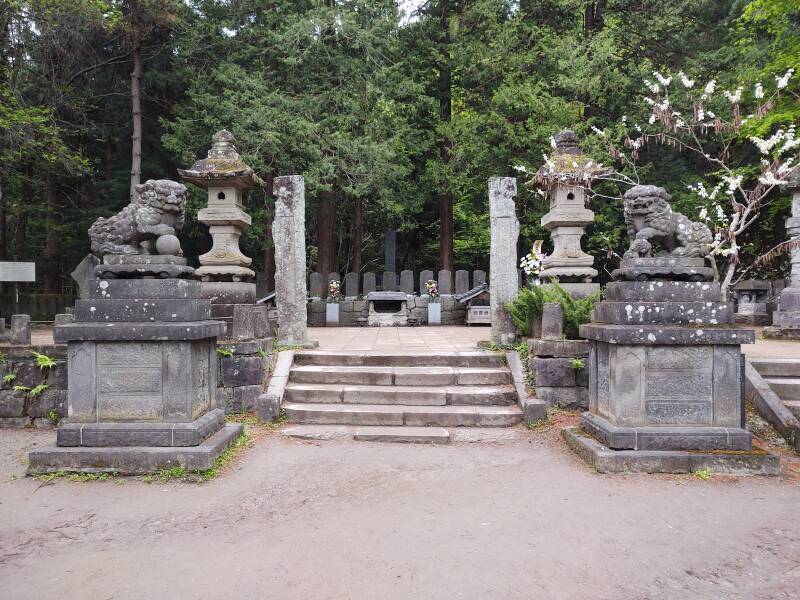
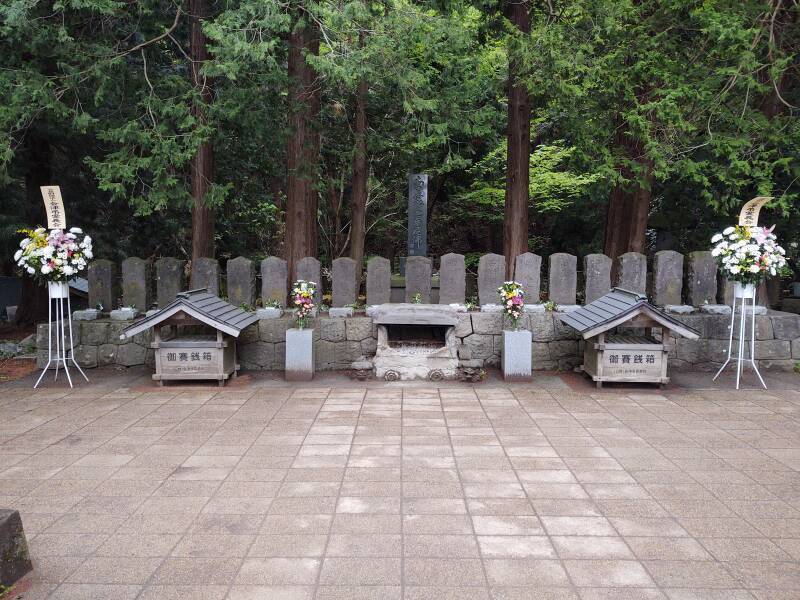
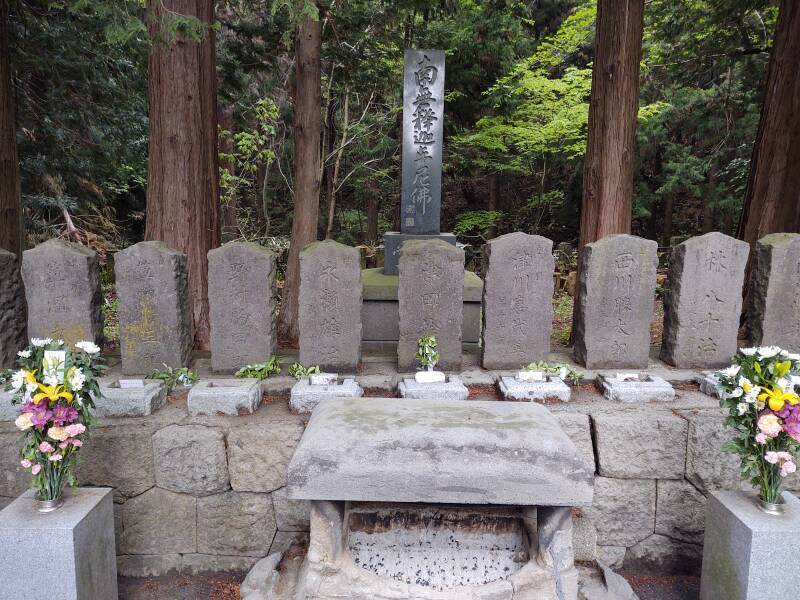

After a month of being besieged by the government's improved artillery, the leaders of the Aizu forces agreed to surrender. Most of the samurai were sent to prisoner of war camps at the northern tip of Honshū, Japan's largest island.
Some fled on their own to the north, crossing to the large island of Hokkaidō.
Some of those continued beyond Hokkaidō to the 930-km-long Sakhalin island, which Japan surrendered to Russia in 1875 and then re-seized in 1905 near the end of the Russo-Japanese War.
A group of 22 samurai and their families went to California, establishing the first Japanese settlement there and the only overseas samurai settlement. Their Wakamatsu Tea and Silk Farm Colony outside Sacramento failed within three years.
Aizu had been famous for its military prowess, constantly maintaining an army of over 5000 samurai. The Shōguns had frequently deployed them to northern Japan, crossing to Hokkaido and on to southern Sakhalin. They had also provided security around Edo Bay around the time when Perry's fleet was there. But the Battle of Aizu ended all that.
On 27 June 1869 the last opposition to the Imperial government was defeated in the Battle of Hakodate, leaving the Emperor as supreme ruler of all of Japan.
The new government demolished Aizu's Tsuruga Castle in 1874. What you see today is a 1965 reconstruction of what had been built in 1611 and used for over 250 years.
The Foreign Memorials
Fascist governments admired the bushidō, the samurai code followed by the Byakkotai. Fascist Italy and Nazi Germany both sent memorials in the 1920s and 1930s. The Italian memorial is the pillar toward the left, the German one is shadowed under the trees near center. The column of the Italian one is from Pompeii, although the inscription concentrates on the glories of Rome and Fascism.

A sign by the Italian column says:
Rome Donation Monument
This monument was a gift given in 1928 from the people and government of Rome, who were impressed by the story of the Byakkotai soldiers. The Italian inscription on the monument reads, "With undying respect, Rome, the mother of modern civilization, dedicates this timeless tribute to the Byakkotai warriors, under the authority of ancient Rome, that this pillar may stand as proof of the greatness of fascism for thousands of years." The back of the monument is engraved with the message "The to 'Flower of Bushido', from the City of Rome".
The pillar is carved in the ancient Roman style, from Roman red granite. At the top of the pillar rests an eagle (a symbol of fascist Italy). The pillar once boasted the images of an axe surrounded with a bundle of rods (another fascist image) at each corner of the base.
Now only the eagle remains in its original state.
After World War II, Allied Occupation troops removed the Fascist axe-and-rods symbols which were fitted into the tall notches at the corners of the white stone base.
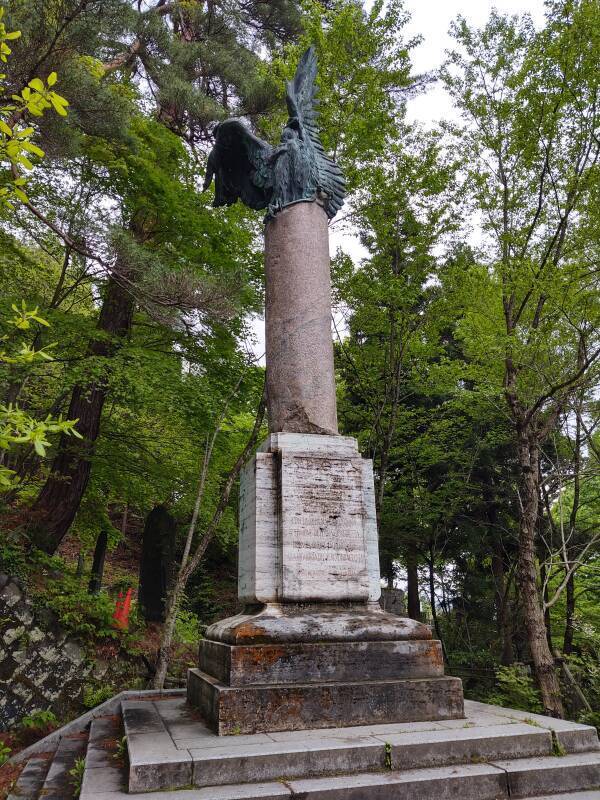

A sign by the German monument says:
Von Etzdorf Donation Monument
In 1934, Von Etzdorf (Secretary of the German Embassy) paid a visit to the area, and was impressed with the spirit of the Byakkotai. He donated this monument in their memory. This monument was built the next year, in 1935. It features the Iron Cross (the symbol of ancient Germany) and an inscription in German which reads, "to the young samurai, from one German man".
The original German monument featured a Nazi swastika, of course. The U.S. replaced it with one bearing the same text.
Iinuma Sadakichi's grave is nearby.
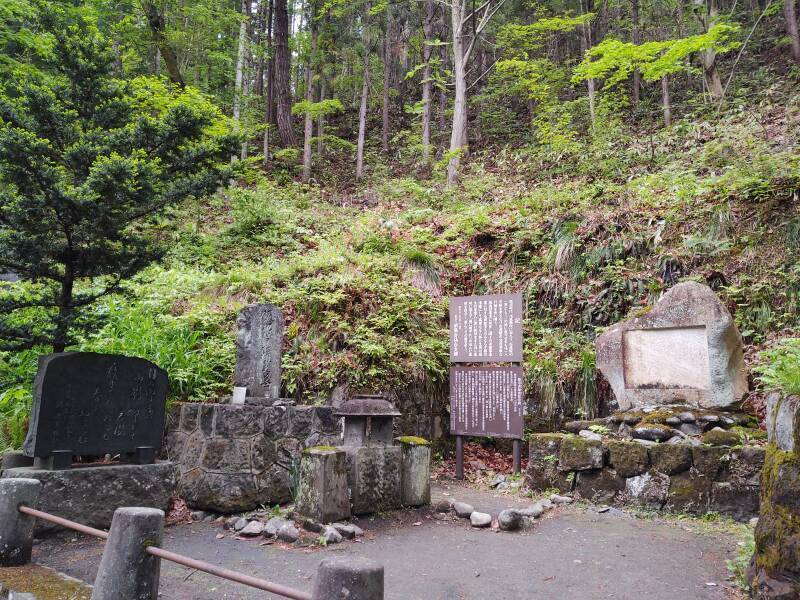
A sign here says:
The Grave of Sadao (Sadakichi) Iinuma
The only member of the Byakkotai who committed suicide to survive was Sadao Iinuma (formerly known as Sadakichi Iinuma). He was aided by Hatsu Inde, wife of Shinzo Inde.
After the war, he became an engineer for the Ministry of Communications, Engineering Director of the Sendai Communications Administration, and made a significant contribution to Japan's communication industry. He passed away in 1931 in Sendai, at the age of 78. It is due to his contributions that the story of the Byakkotai is known today.
On the 90th anniversary event of the Boshin War (held in 1957), the remains of many people who had died were transferred to this area. The gravestones and memorial monument were built by the Maejima Foundation Board, Sendai branch.
He worked as a telegraph engineer and later joined the Imperial Japanese Army and fought in the Sino-Japanese War of 1894. He died in 1931, before the microwave telecommunications developments explained in an earlier page about Aizu-Wakamatsu.
There's another cemetery down the south slope of Iimori Mountain.
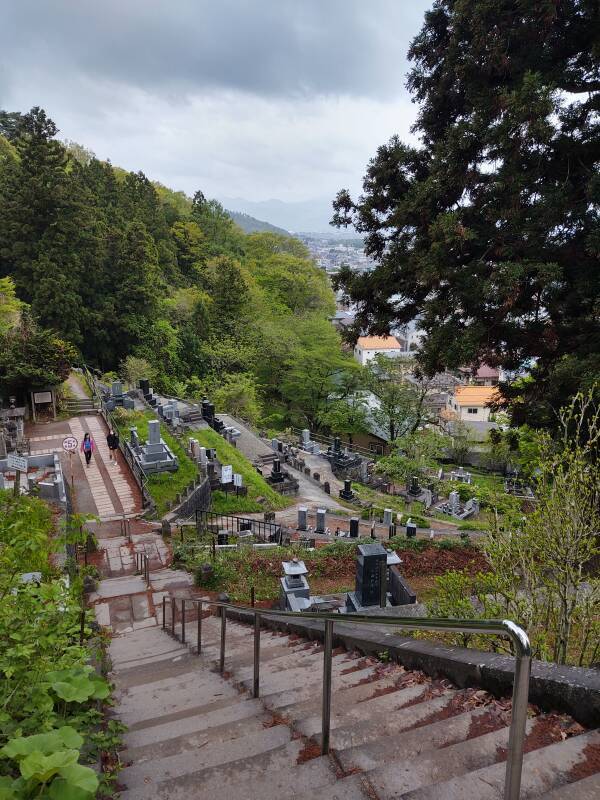
The Byakkotai continue to be a popular topic in movies, TV series, books, and magazines.
Sazae Temple
Descending just one flight of steps from the Byakkotai graves and then turning north, you reach Sazae-dō. This octagonal pagoda was built in the 18th century.
Shintō and Buddhism in JapanShintō and Buddhism had become blended ever since Buddhism's arrival from China in the 6th century CE. Buddhist temples would be attached to Shintō shrines, and vice-versa. The Buddha and various Bodhisattvas were interpreted as manifestations of Shintō kami or spirits, and vice-versa.
That process was called Shinbutsu-shūgō. The civil wars around the Meiji Restoration had pitted the Shintō Emperor against the Buddhist Shōgun, warlords, and samurai. The newly powerful Meiji Emperor called for Shinbutsu bunri, splitting them apart while strongly favoring Shintō if there's any conflict.
This Buddhist temple had housed 33 statues of a Buddhist goddess. They were removed soon after the Meiji Restoration.
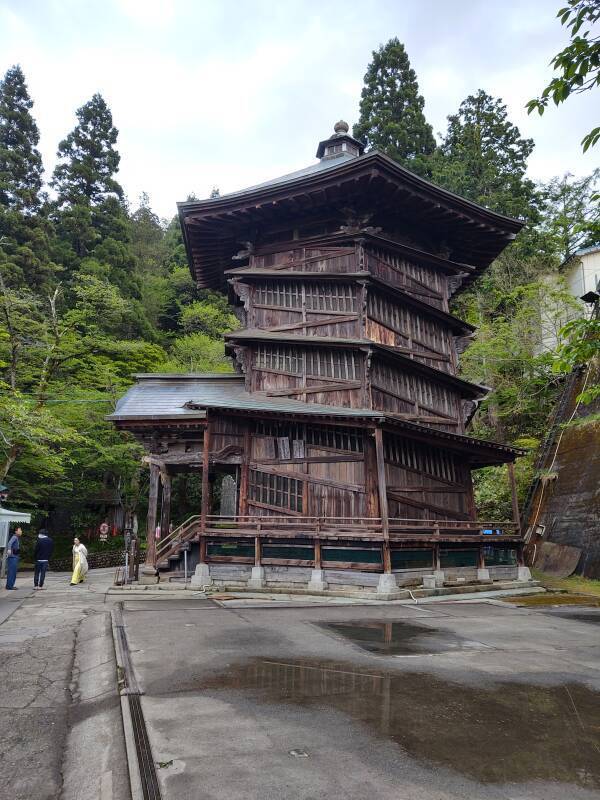

The forced separation did not work out the way the Emperor wished. People kept dying and Buddhism provided the funerals and ancestor rites.
The result of the attempted Shinbutsu bunri separation was that the Japanese people, who had already been vague about the distinction between Shintō and Buddhism, ended up much more confused. At Buddhist temples today you see local people doing the distinctive double clap meant to awaken the deity at a Shintō shrine. Many Buddhist temples with a significant number of foreign visitors have a sign in English displaying something like "NO CLAP! THIS IS BUDDHIST TEMPLE!". But it's not the foreigners, it's the locals who are annoying the Buddhists with all the Shintō clapping.

The Tonoguchi Weir Cave feeds the stream that flows around and between the small shrines below the pagoda.
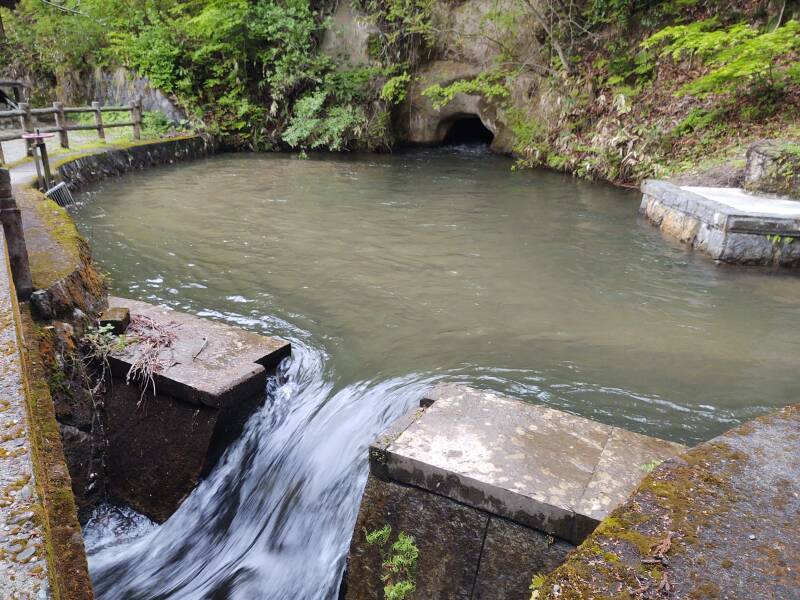
A Shintō shrine here is Uga-shindō. It was built during the late 17th century and deifies a white snake as a god of abundance and fertility.


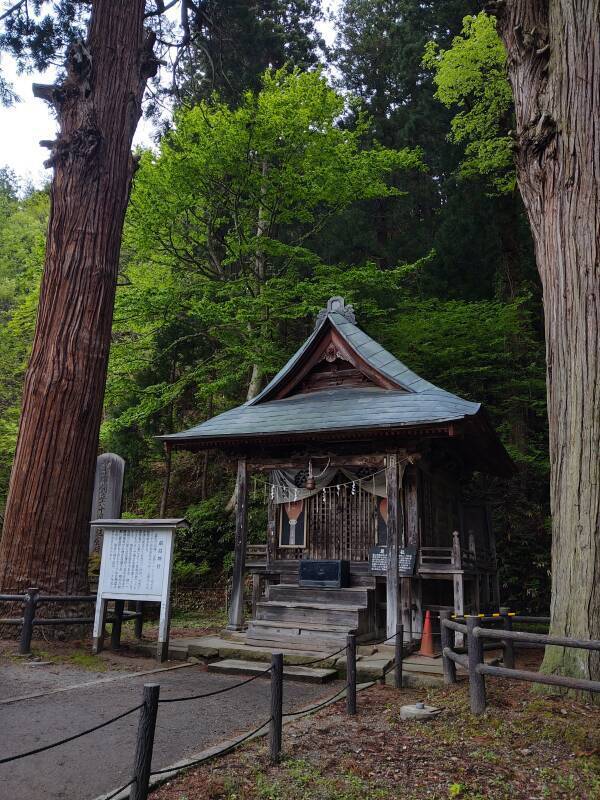
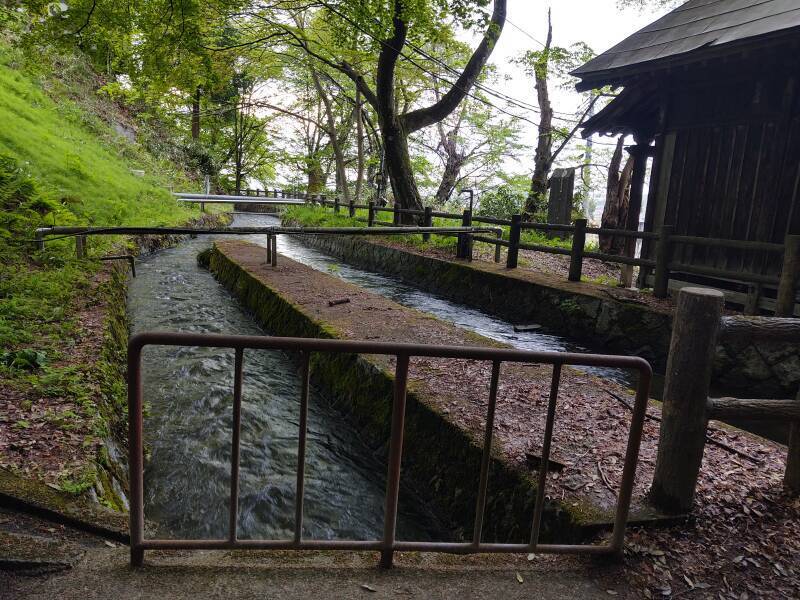
The last page in this series takes us to the nearby town of Kitakata, which has the highest ratio of ramen shops per person in all of Japan.
Other topics in Japan:



































